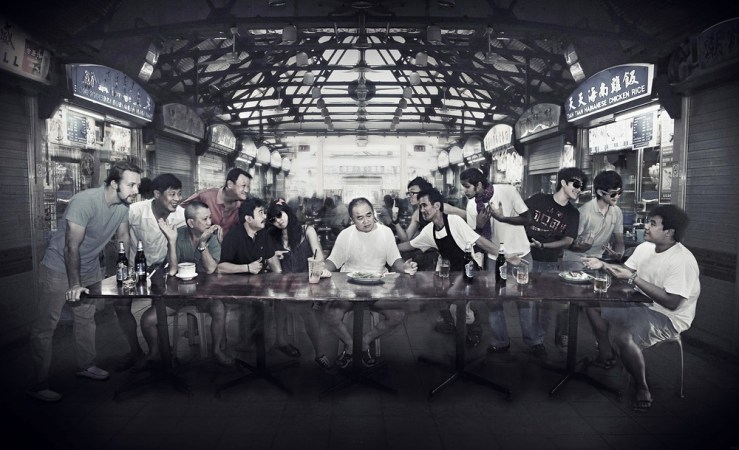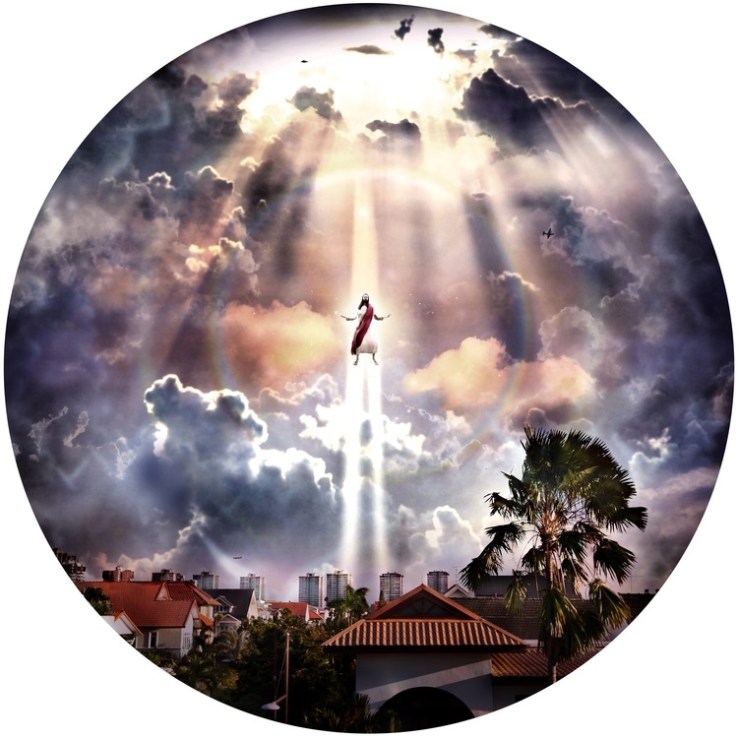In 2010 Eugene Soh was enrolled in Nanyang Technological University’s School of Art, Design, and Media, on track to becoming a game programmer, when Campus magazine, aware of his photography hobby, asked him if he’d like to contribute a centerfold to an upcoming issue. He said yes but, after combing through his photos, realized he had nothing great to offer—he’d have to shoot something new, something epic. He chose to restage Leonardo da Vinci’s Last Supper at Maxwell Road Hawker Centre (a “hawker center,” or kopitiam, is what Singaporeans call their open-air food courts), using vendors as models for Christ and his disciples.

The photo was published but went without much notice until two years later in 2012, when it went viral online. Galleries started contacting him to do shows, not realizing that The Last Kopitiam was a one-off thing. Soh decided to finish out his concentration in interactive media, graduating in 2013, and then to pursue fine art photography as a career.
Encouraged by the interest in his Leonardo adaptation, Soh translated more Western art masterpieces into a contemporary Singaporean idiom, among them the Mona Lisa (renamed Moh Lee Sha), The School of Athens (Food for Thought), The Birth of Venus (Arrival of Venus), Saturn Devouring His Son (Saturn Devouring His Naan), A Sunday on La Grande Jatte (Sunday Afternoon on the Island of Singapore), Arrangement in Grey and Black No. 1 (Arrangement in Grey, Black and Yellow), and American Gothic (Singapore Gothic).
His Creation of Ah Dam, after Michelangelo’s famous Sistine Chapel ceiling fresco, shows a wet-market grocer transferring the spark of life to “Ah Dam” via carrot.

It is Soh’s process, as demonstrated in these photos, to shoot his human subjects separately and then stitch them together digitally to create a single composite image. The hawkers in The Last Kopitiam, for example, couldn’t all get away from their stalls at the same time, so this sort of cut-and-paste manipulation was born out of necessity. At first Soh was resistant to using Photoshop in this way, thinking of it as “cheating,” but he quickly became convinced of its legitimacy and artistic potential.
Earlier this year Soh developed a new series called The Second Coming, which reenvisions the life of Christ on Singaporean soil (much like David LaChapelle did, for America, in his 2003 series Jesus Is My Homeboy). Mounted as a solo show in February and March at Chan Hampe Galleries, The Second Coming draws on familiar devotional image types, like the Madonna and Child, the Crucifixion, and the Pietà, as well as invents some new ones, like Jesus answering his cell (Hold Up, Dad’s Calling) or helping one of his hosts prepare dinner (What’s Cooking, Jesus?).
In Happy Birthday & Merry Christmas, Jesus, Jesus blows out the candles on his cake. The mise-en-scène includes a foam crown, maracas, and an umbrella drink.

In contrast, the mood of The Last Christmas is gloom and doom. According to the artist, Jesus has just announced that he is going to destroy the world, putting a damper on the birthday festivities (though one attendee chooses to make light of the news). Staged like a Last Supper, this imagined scene takes place immediately preceding Armageddon. It’s everyone’s last Christmas.

Reminiscent of Jesus preaching the Sermon on the Mount, New Testament 2.0 shows a crowd gathering in UOB Plaza with McDonald’s takeout and tourist maps to hear Jesus sermonize. One listener records him on her phone while another—Mary Magdalene—appears to be scrolling for information on hers, perhaps investigating something he said.

Jesus is modeled throughout the series by Singaporean spoken word artist Marc Nair, wearing a long, straight, dark wig and a well-groomed beard and mustache. In Standard Portrait of Jesus he stands in a strong frontal position with nail-pierced hands joined in prayer, his head haloed by a fluorescent ring light (a common lens attachment in fashion photography). Soh describes this as Jesus’s press photo; it expresses the qualities of benevolence and gentleness Jesus wants to characterize his brand.

In Madonna and Child, though, Jesus is portrayed by the artist’s nephew, Kieren Lin. Paperkitties beauty blogger Alene Breddemann portrays Mary.

I read this all as a recasting of Jesus’s first coming, though the artist, as the series title suggests, explains that he is picturing what it might look like if Jesus were to visit Singapore during his return to earth at the end of time. So the photograph The Second Coming, though it looks like an Ascension, is actually intended as a Descension—Christ coming back “to judge the living and the dead,” as the Creed has it. And the site of descent is Jalan Kembangan.

The visual similarity between the Ascension and the Parousia makes biblical sense:
And when he had said these things, as they were looking on, he was lifted up, and a cloud took him out of their sight. And while they were gazing into heaven as he went, behold, two men stood by them in white robes, and said, “Men of Galilee, why do you stand looking into heaven? This Jesus, who was taken up from you into heaven, will come in the same way as you saw him go into heaven.” (Acts 1:9–11)
Soh’s Second Coming series is meant to be light and playful, but it was also a vehicle for Soh to revisit the Christianity of his youth, working through some of the questions that remain unresolved in him. In Praying to Myself, for example, Soh said he was interested in highlighting the Father-Son relationship. Are Father and Son the same entity? If so, what was the point of Jesus praying? And if not, did the two ever possess opposing views? Wouldn’t that break the unity of the Godhead?
Soh also considers the issue of textual reliability. How do we know that the New Testament is an accurate record of who Jesus is? If Jesus had first come to earth in this age of technology, we could have recorded everything he said and did for posterity. We’d have photos and videos mass distributed over the Internet and commented on by people of all stripes. But because he came into an ancient culture where oral tradition was the primary means of communication, a gap exists between the actual events and their written record. Is this gap a cause for concern? What about the partiality of the writers? Discrepancies between accounts?
The series has sparked spiritual discussions among theists, atheists, and agnostics, Soh said, and he has enjoyed engaging them.
Creating art for Christian devotion was not Soh’s intent with The Second Coming, but there is one photo from it that I find most beautiful and appreciate on a spiritual level, and that’s Resurrection. It shows Mary Magdalene at Jesus’s tomb, having come with spices and herbs to finish the burial preparations. Upon arrival, though, she sees his risen body (out of frame) and, overcome by gratitude, collapses to the ground in praise, sending the containers scattering. The blood-stained shroud draped over Christ’s bier remains as a reminder of the death he suffered on our behalf.

To view all fifteen photographs from Soh’s Second Coming series along with the artist’s descriptions, click here.
